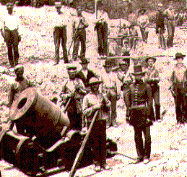Civil War and Reconstruction
During the Civil War, Florida was not ravaged as several other southern states were. Indeed, no decisive battles were fought on Florida soil. While Union forces occupied many coastal towns and forts, the interior of the state remained in Confederate hands.

Florida provided an estimated 15,000 troops and significant amounts of supplies— including salt, beef, pork, and cotton—to the Confederacy, but more than 2,000 Floridians, both African American and white, joined the Union army. Confederate and foreign merchant ships slipped through the Union navy blockade along the coast, bringing in needed supplies from overseas ports. Tallahassee was the only southern capital east of the Mississippi River to avoid capture during the war, spared by southern victories at Olustee (1864) and Natural Bridge (1865). Ultimately, the South was defeated, and federal troops occupied Tallahassee on May 10, 1865.
Before the Civil War, Florida had been well on its way to becoming another of the southern cotton states. Afterward, the lives of many residents changed. The ports of Jacksonville and Pensacola again flourished due to the demand for lumber and forest products to rebuild the nation's cities. Those who had been slaves were declared free. Plantation owners tried to regain prewar levels of production by hiring former slaves to raise and pick cotton. However, such programs did not work well, and much of the land came under cultivation by tenant farmers and sharecroppers, both African American and white.
Beginning in 1868, the federal government instituted a congressional program of "reconstruction" in Florida and the other southern states. During this period, Republican officeholders tried to enact sweeping changes, many of which were aimed at improving conditions for African Americans.
At the time of the 1876 presidential election, federal troops still occupied Florida. The state's Republican government and recently enfranchised African American voters helped to put Rutherford B. Hayes in the White House. However, Democrats gained control of enough state offices to end the years of Republican rule and prompt the removal of federal troops the following year. A series of political battles in the state left African Americans with little voice in their government.
